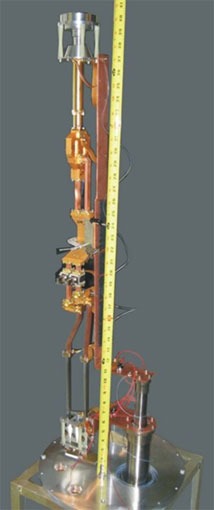F. J. Lockman

Figure: The first pixel of the GBT KFPA during test assembly in the lab. The base plate of the dewar is at the bottom with the sliding thermal waveguide joint attached to it at the left, and the refrigerator to the right. Above the waveguide are the amplifiers, isolators, noise cal source, orthomode transducer, phase shifter, and at the top, the thermal gap. All of this will be within the dewar. Above this assembly will be the dewar top, then the feed horn. The assembly is tall and slender so that all components fit within the feedhorn shadow.
 Zoom
Zoom
The 7-pixel K-band Focal Plane Array (KFPA) project reached a milestone on August 28, 2008 when the first complete pixel was installed in the test dewar and successfully cooled to 15 deg K. This array is the first in a planned series of new multi-pixel heterodyne instruments for the GBT. It will operate in the 18-26.5 GHz frequency range with dual-polarization receivers at each pixel. The 7-pixel array is not only an important scientific instrument, but the prototype of a larger 60-pixel array for the 18-26 GHz band, and for arrays of >100 pixels at 3mm and other bands. Along with the 3 mm bolometer array MUSTANG, which begins shared-risk use this winter, the 7-pixel KFPA marks the start of an exciting new development phase in GBT capabilities.
Integration of the receiver into the dewar was the beginning of the KFPA lab test period. If all goes well, the receiver will be mounted on the GBT on September 9, and will begin sky tests shortly thereafter. The figure shows the first pixel on a lab bench before installation into the dewar. It is a complete receiver and includes all components which will be part of each subsequent pixel.
The KFPA uses some components that are newly made for this project, and their performance will be subject to special scrutiny over the next few weeks. These include the sliding waveguide expansion joints, the noise module, the thermal gap, the integrated MMIC down converter, and the Ethernet-based monitor and control communications link. The tests will check for system stability, system temperature, bandpass shape and stability, noise calibration, and the monitor and control circuitry and software. Once installed on the GBT tests will be made over the complete path back to the control room, and will include some spectra using the GBT spectrometer and continuum scans using the DCR.
The single pixel can be positioned at several locations in the focal plane, allowing us to understand aperture efficiency and beam shape differences that elements of the full array may ultimately exhibit.
After this first series of tests is analyzed a second set will be performed in October, with the goal of gathering data so that a critical design review of the entire project can be performed toward the end of this calendar year. The development plan calls for single pixel tests in 2008, full 7-pixel array tests in 2009, and release of the completed array for general observer use in late 2010.
Work is also progressing on the software pipeline for KFPA data reduction. We are in the process of defining and characterizing observing modes and developing the methodologies needed to reduce the data. At this stage it seems likely that most of the software will be reused from other projects and relatively little will be created from scratch. Notes from a data analysis meeting which was held in June and a draft memo by D.J. Pisano on spectral line observing with the
KFPA, as well as photographs and progress reports are available on the project wiki: https://wikio.nrao.edu/bin/view/Kbandfpa/.

 Zoom
Zoom